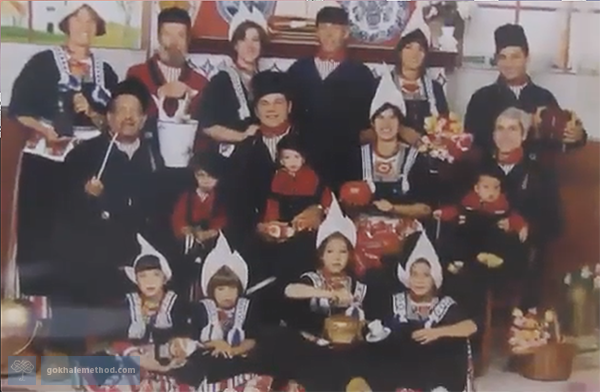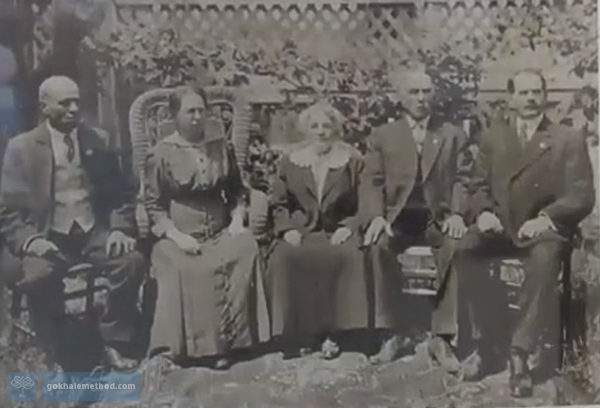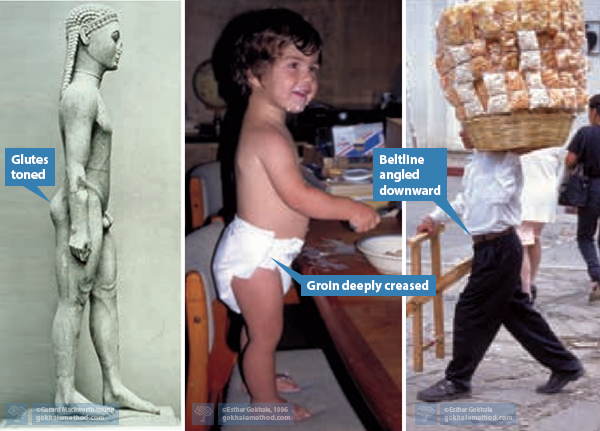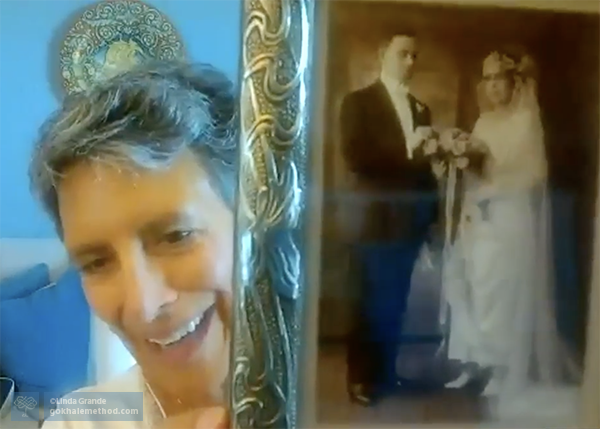Old Family Photos are a Great Posture Tool: Part 2: Lower Body
Rediscovering ancestral posture can be fun! In our online 1-2-3 Move program we have had several “Show and Tells” during which participants share old family photographs. The inspiration for healthy posture and positive change that these pictures bring to their descendants, as well as to the online community, is powerful.


Here I am showing a photograph of me with my extended family in Holland. The tailoring of the traditional costumes we wore helped us to sit and stand with open, relaxed, and upright posture.
In Part 1 of this series we looked at the upper body. Here we are going to consider what our forebears can teach us about healthy alignment for the lower body—specifically, what needs to happen with the pelvis, legs, and feet.
Ancestral photographs provide compelling evidence for what is taught in the Gokhale Method and can be a posture lesson in themselves. For example, in the print below it is striking that everyone is sitting on an anteverted pelvis, with externally rotated hips and legs, and feet angled outwards.

This group portrait shows how people sat with an anteverted pelvis, external rotation in their hips and legs, and feet pointing outward. It is one of several spare antique photographic prints donated by the Mendocino County Museum to the Gokhale Method Institute’s collection and also featured on the 1-2-3 Move exercise program.
Pelvic anteversion
Pelvic anteversion is the natural and healthy position for the human pelvis, in upright sitting and standing. “Anteversion” means the pelvic rim settles at a slight forward angle, rather than the “neutral” or “level” position which is often taught as ideal today. Most people in modern societies “tuck” or “retrovert” the pelvis in the opposite direction to anteversion, and consequently get into various kinds of trouble.
Anteversion is the pelvic angle you still see in historical artefacts, in our infants and children, and in populations throughout the non-industrialized world that suffer far less back pain than we do. This is explained and illustrated in detail in my book, 8 Steps to a Pain-Free Back. Below are just a few examples.

Antique statues, infants, and people in more traditional cultures all show a naturally anteverted pelvis.
Legs externally rotated
Pelvic anteversion is natural for our species, but was more prevalent prior to the 1920s, when traditional posture was still preserved and people had good role models. The prevailing dress codes of past times were also more conducive to healthy posture and movement patterns. For women, long, wide skirts allowed the legs to widen and the pelvis to settle well. In shorter skirts women tend to turn the knees inwards because of moral codes. Tight skirts and jeans will also tend to limit the range of movement in the hips in a way that traditional clothing does not. (Note: there is a healthy way to antevert the pelvis even when the knees are close together, but this takes a little more education and training.)
Pelvis nestled
A well-trained eye can also discern from a photograph the deep nestling of the pelvis between the leg bones that takes place when the legs are externally rotated. This nestling enables people to sit more forward on their sitz bones in an upright but relaxed position (below left). With the more common tucked pelvic position of modern times, a person is left with two equally unhealthy options for the torso: relaxed and slumped (below center) or upright and tense (below right).

We have forgotten how to be upright and relaxed to the extent that when we look at old photographs with upright people, we mistakenly imagine that they are stiff and must be exerting a lot of effort to be upright.
Feet pointing outward
If you are lucky enough to have full-length family portraits you will see that the feet are angled outward in standing. This arises naturally from having external rotation in the hips. The current conventional wisdom that the feet should be parallel interferes with the healthy alignment and function of the lower limbs and pelvis. Without external rotation, feet are more likely to pronate (roll inward), knees to collapse inward (knock knees), and the pelvis will not articulate well with the heads of the femurs (hip joint). Students have reported much improvement in hip bursitis and impingements in the groin from gently progressing external rotation over time using Gokhale Method techniques.

1-2-3 Move participant Linda Grande shares a photograph of her grandparents, taken around 1916, who emigrated from Sicily and met in Brooklyn. They both show beautiful posture, including outward pointing feet.
Finding external rotation
Our 1-2-3 Move Alumni exercise program gives participants further practical posture experience as well as sharing compelling history and theory. Below is a short video clip in which I introduce and teach a traditional Indian dance (Bharata Natyam) movement, which I learned as a child in Mumbai. Like most traditional dance forms, it encourages external rotation of the hips, legs, and feet. Dance is an excellent way to learn new movement patterns and make them feel familiar. Try this move for yourself!
Traditional dance forms such as Bharata Natyam encourage external rotation of the hips, legs and feet.
The Gokhale Method® approach to posture and movement is always holistic, supports good habits, and develops healthy alignment that protects joints and soft tissues from injury. You can find out more in one of our new FREE Online Workshops. If you would like an expert one-on-one assessment of your posture and especially your lower body alignment, you can arrange an Online Initial Consultation or take an in-person Initial Consultation if you have a Gokhale Method Teacher near you.

Comments
Add New Comment
Login to add commment
Login